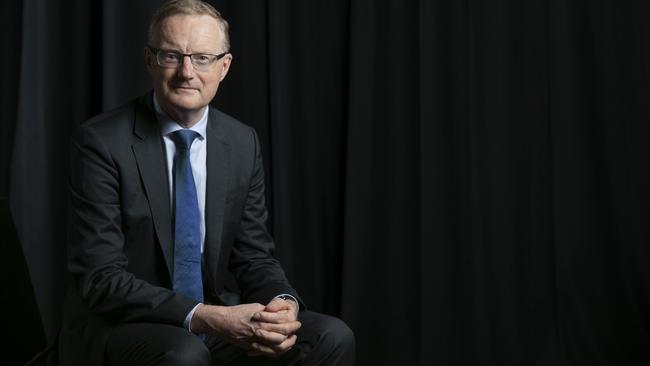RBA governor Philip Lowe Central bank has confidence in consumers
Reserve Bank governor Philip Lowe remains confident consumers will throw off recent gloom and begin to spend.

Reserve Bank governor Philip Lowe remains confident that consumers will throw off recent gloominess and begin to spend the extra cash that has flowed from tax and interest rate cuts.
That’s just as well, because the federal government is “highly unlikely” to deliver any material stimulus in its mid-year economic and fiscal outlook next week, according to UBS.
While a slight increase in Australia’s economic growth rate in the September quarter was in line with the RBA’s expectations, flatlining household consumption growth came as a “surprise” to the central bank, Dr Lowe told a conference on the payments system on Tuesday.
“The evidence over time is that if Australians have extra income they spend a fair chunk of it,” Dr Lowe said in response to a question about the September quarter national accounts data.
It was “quite possible” in an environment of high household debt and low wages growth that it was “taking a bit longer” for the stimulus to flow through to the economy.
Moreover, the delayed response to stimulus by consumers did not contain “any particular messages about the future” of the economy.
Dr Lowe’s comments followed the release of national accounts data last week showing that the economy grew by 0.4 per cent quarter on quarter and by 1.7 per cent year on year, about its weakest pace in a decade.
But UBS chief economist George Tharenou said his analysis showed that the limited response of the economy to interest rate cuts this time was “different”.
“Indeed, we continue to expect the economy will disappoint the consensus and the RBA, and that further policy stimulus in needed,” he said.
The central bank has cut rates three times since June, lowering the official cash rate to a record low of 0.75 per cent.
At the same time, the government has eased fiscal policy via an income tax credit in July that will be worth almost $17bn in the year to June.
But Mr Tharenou maintained that with no accelerated fiscal stimulus on the cards next week, the RBA was “highly likely” to cut its cash rate to 50 basis points in February, then cut to 0.25 per cent by mid-2020, assuming global central banks continue to ease monetary policy.
“Amid the worst consumption and economic growth since the global financial crisis, there are calls for the government to do more, and pull forward about $22bn of ‘phase-2’ tax cuts, from 2022-23 to July 2020,” he noted.
“However, even though the budget is in balance, and government debt is low by intentional standards, we still think the risk of an upside surprise from material fiscal stimulus is now limited.
“This reflects the government’s commitment to surplus, amid press reports that S&P said if ‘fiscal stimulus involves substantial spending initiatives and changes the trajectory of the budget, then doing so could increase downward pressure on Australia’s AAA rating and outlook’.”
Mr Tharenou said the budget was still on track for a $7.1bn surplus in 2019-20, reflecting a boost from better-than-expected iron ore prices, offset by a weaker coal price, and slower economic growth and consumption.
“While the budget could upgrade its iron ore price forecasts, we think it will remain relatively conservative and project prices only gradually declining towards about $US60 a tonne over coming years,” he said.
“Nominal GDP forecasts are already optimistic and unlikely to be revised up.”
With the budget assuming a material $22bn improvement in the next eight months — a much larger-than-normal “seasonal” lift, partly reflecting the pull-forward of tax refunds that roll off in the rest of 2019-20 — the “MYEFO has little scope for an upside surprise versus the budget projections”.
“Hence there is limited room if any for further fiscal stimulus, without deteriorating the forecast surpluses,” Mr Tharenou said.
Australia’s economic growth rate increased to 1.7 per cent in the September quarter, from 1.6 per cent in the June quarter, but consumer spending rose just 1.2 per cent — the weakest since the GFC — and the household savings rate rose from 2.7 per cent to 4.8 per cent — the highest in 2½ years, showing rate cuts and government tax cuts have so far been saved rather than spent.
While consumer demand remained in a slump, household income grew solidly, and it was government spending and booming exports that gave the economy some support.
The RBA retains optimistic forecasts for GDP growth in 2020, with many economists now expecting the central bank will revise them down in February, with two more interest rate cuts widely anticipated during the year.
While remaining confident the policy stimulus would increase economic activity, Dr Lowe pointed to his emphasis on the “long and variable lags in the transmission of monetary policy”.



To join the conversation, please log in. Don't have an account? Register
Join the conversation, you are commenting as Logout